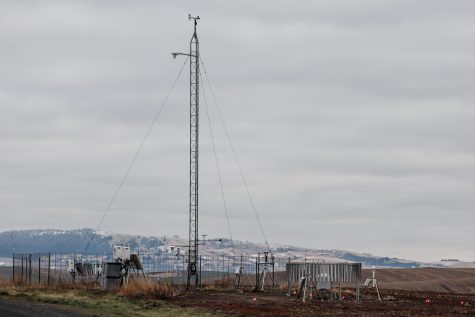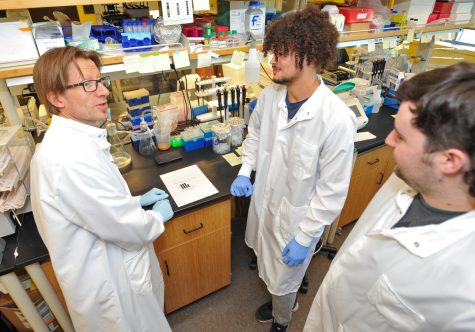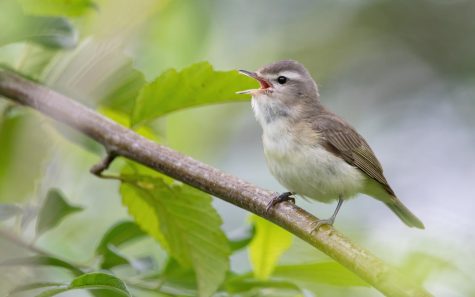WSU grizzly bears are out of hibernation
WSU Bear Center studying hibernation; research has implications for human health
Veterinarian Dr. Gay Lynn Clyde (back) (center) and vet tech Jessie McCleary (left) finish taking small fat and blood samples from anesthetized female grizzly bear Kio while vet student Christina Negretti (right) monitors Kio’s vitals.
March 24, 2022
It is that time of year. From Idaho’s Bitterroot mountains to the forests of Sweden, brown bears are coming out of hibernation. The grizzly bear, one of six subspecies of brown bear, is native to the Pacific Northwest.
The resident grizzlies of the WSU Bear Center are also up and about, thanks to warmer and longer spring days.
“Their whole physiology has already been changing for several weeks now,” said Charlie Robbins, founder of the center. “They start getting active about Feb. 15.”
Resident bears cannot be released back into the wild due to injury or habituation to humans. Robbins said he founded the center 36 years ago to house these bears and answer questions about their wild counterparts. It remains the only facility of its kind in the country.
“It’s really here to facilitate research in wild bears,” said Heiko Jansen, a faculty member at the center. “We help the agencies managing wild bears answer questions they can’t in zoos and the field. The biomedical aspects are here to hopefully gain insight into treating human disease.”
The bears both enter and come out of hibernation naturally as the weather changes; the faculty at the center do nothing to interfere with the process. All the bears need in their four months of hibernation is water and soft straw for bedding. They receive no food from Nov. 1 to March 11.
Hibernation is an incredible feat of bear biology and is being researched at the center. During hibernation, bears do not eat, drink, urinate or defecate, Robbins said. They maintain their bone density, muscle mass and strength. Most research conducted at the center investigates how bears hibernate.
“We’re just trying to understand that process from the genetic level all the way up to the overall organ physiology,” Robbins said.
The week before spring break, each bear received a post-hibernation check-up. Veterinarians checked their weight and collected small samples of fat and blood for research. Heather Havelock, senior wildlife ecology and conservation major, helped with the check-ups, emphasizing how valuable experience at the Bear Center is for students.
“You learn so much about the bears every single day; not just about nutrition and physiology, but enrichment as well,” Havelock said.
Enrichment activities provide outlets for resident bears’ natural instincts and behavior, keeping them happy and healthy when they are not hibernating.
WSU and Texas A&M are partnering for a study on how bears can both build so much protein in the summer and retain it in the winter.
“The goal here is to track how proteins are made. Proteins are made with twenty amino acids, twenty different building blocks,” said Perry Barboza, an expert in wildlife nutrition from Texas A&M.
Barboza said that until recently, there was no technology available to track proteins. However, the advent of new human technologies opened the door for measuring protein mechanics in bears.
Using a combination of technologies, researchers track protein building and loss. Heart rate monitors provide data on each bear’s daily life: body temperature, posture, activity level, body fat, respiration rate and hydration.
The research being conducted with the bears also has implications for human health.
“Bears become insulin-resistant like diabetics do during hibernation, but they don’t suffer the consequences of diabetes,” Jansen said. “We’re trying to understand how they flip this switch every year.”
The collaborative study is revealing bears may have more in common with humans than previously thought.
“It looks like we’re omnivores, of course, it looks like they’re omnivores too, and they may have the same metabolic rates that we do,” Barboza said.
Another mystery Barboza seeks to answer is how costly it is for bears to change their diets from mainly carnivorous to mainly herbivorous.
“We’re using the heart rate monitors with these guys to work out in the summer how costly it is to start changing diets,” Barboza said.
To learn more about the bears, visit the Bear Center. Next weekend, the bears will enter their outdoor yard, where you can view them most times of the day.


















